
Fat sand rat
 Fat sand rat |
The small mammals that I see most often are bats, Israel's most common native mammals, of which there are over 30 species. Today several are endangered in part due to mass poisonings in earlier decades when DDT was widely (and successfully used) to wipe out dangerous mosquito populations. Bats were also targetted by farmers in the mistaken belief that all bats are fruit bats - in fact there is only one species of fruit bat in Israel, all the rest are insectivores, and as such are very helpful to humans.
The Egytpian fruit bat is a fairly large "flying fox" type bat with an intelligent looking face. They are attracted to many fruit trees, and so plague gardeners and fruit growers alike, both because the eat the fruit and because they leave sticky droppings, soiling the pavements and any laundy hanging in the yard. They are particulalry fond of ficus sycamore trees (the biblical shikma), a tree which is especially common in certain parks and boulevards in Tel Aviv. Look out for them flitting around the sycamores unphased by the bustling streets and traffic, feasting on the fig like fruit as the perch upside down on the branches.
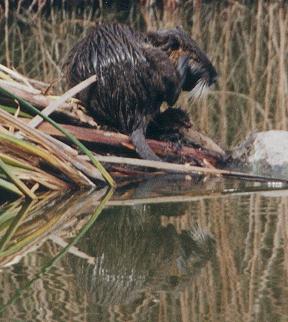 Nutria at the Hula wetlands |
In most Israeli towns it's not unusual to see small insect hunting bats chasing moths under streetlamps on warm evenings. While these fluttering darks shapes are rather spooky and people are often understandably afraid of bats, I think that if you watch them and get used to them they are fascinating creatures, certainly some of God's weirder creations.
Some of Israel's smaller mammals whose presence you're most likely to come across include three species of hedgehog as well as the Cape or brown hare and the Indian crested porcupine, Israel's largest rodent. Most of these are nocturnal, living in burrows or hiding under rocks or bushes by day.
Sadly you are most likely to see these as roadkill. On a couple of occasions we've narrowly missed hitting a hare or hedgehog frozen in the middle of the road, dazzled by the car lights before bounding or scurrying off to the relative safety of the roadside woods or bushes.
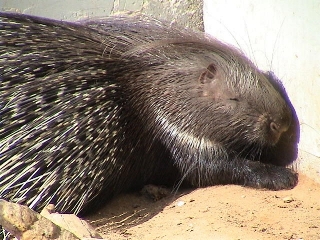 Porcupine |
Hedgehogs can occasionally be found in urban gardens, though I've more often seen them when staying in rural or desert areas, depending on the species. The East European hedgehog is probably the species you are most likely to see in the densely populated centre of the country.
The smaller long-eared hedgehog is more likely to be found in peripheral areas, near dunes or agricultural lands, and is usually quite easy to recognise by it's creamy pale, pointy, shrew-like face, with a high forhead devoid of quills.
It's desert cousin the desert or Ethiopian hedgehog is restricted, as its name suggests, to the desert, though sometimes it's territory overlaps with that of the long-eared. While all hedgehogs are insectivores, the desert hedgehog is a particularly intrepid hunter whose diet includes some of the most dangerous scorpions to be found in the deserts of the Middle East and North Africa.
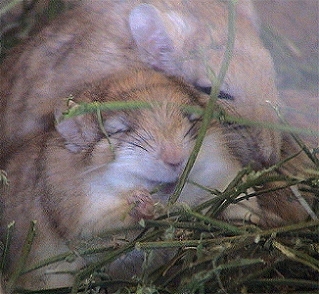 Sundevall's Jird |
Israeli hedgehogs will hibernate during the colder winter weather, though the east European species will generally do so only for a few days a time during extremes of cold, remaining active for much of the winter. By contrast North African desert hedgehogs, hibernate during the fierce Saharan summer, while Israeli desert hedgehogs due so during the chilliest days of winter.
On walks in the woods or along country footpaths keep an eye open for porcupine quills, often beautifully coloured in shades of brown, black and white. The porcupines themselves are far more elusive, though with their huge bustle of quills they are surprisinly large creatures, the huge train of quills inflating their size and producing a distinctive rustling sound as they move.
Porcupines mostly feed on bulbs and similar subterranean parts of plants, as well as ripe fruits and vegetables growing close to the ground. Farmers understandably consider them a pest, and with no natural predators other than the highly endangered leopard, porcupine numbers are kept in check by hunting in agricultural areas.
Though more common in rural areas some do make their homes in town gardens. A few years back there was a story in a local Jerusalem newspaper about a porcupine family which settled in the yard of an apartment block in the city's Kiryat Hayovel neighbourhood. Some residents of the building where thrilled to see these impressive animals up close, others were frightened because of the myth that porcupines can "shoot" quills at people.
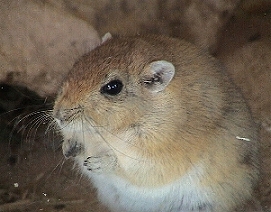 Fat Sand Rat (fat jird) |
Israel is home to a large variety of small rodents, from the exotic sounding Bandicoot rat, Cairo spiny mouse, desert jerboa and jirds to the more mundane sounding brown rats, mole rats and dormice.
The region is home to one of the world's most popular rodents, a denizen of pet shops and school pet corners the world over - the gerbil. Yes, that creature so many parents fork out good money for, only to have it die a year or two later, runs around wild here. Israel is also home to grey hamsters,a wild cousin of that other popular classroom pet.
The most I've usually seen of any of these creatures is something small and furry scurring for cover in a grass verge or running across the road at night on a quiet rural road. I have had some nice sightings of desert spiny mice, mostly in the crater edge town of Mitzpe Ramon in southern Israel. There are two local species of this charming little spiky furred rodent, the Cairo spiny mouse and the golden spiny mouse. While both species are usually nocturnal, in areas where they overlap the golden spiny mouse becomes active by day, to avoid competition with with it's rival species.
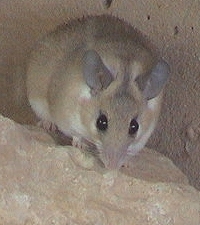 Cairo Spiny Mouse |
The most interesting cute furry rodent I've spotted close to home was a social (Gunther's) vole, in roadside thick foliage by the Titora Hill nature area in Modi'in. These creatures are usually nocturnal, but in cold weather they are they're often active during the morning and early evening.
This fellow was happily foraging in undergrowth not far from my home, and seemed quite unafraid, so I had a good close look at him. At first I thought it was some kind of rat, a large, dark, stocky rodent, but then I noticed its short tail and softer, rounder, more rabbit like face, and small round ears. Much nicer looking than a rat.
I'm sure farmers in the area would be less thrilled to see these voles as they can do a great deal of damage to local crops. In many areas there have been attempts to control the vole population by bolstering the number of predators in the area, such as barn owls, and indeed, I have often noticed these owls near and directly over the Titora Hill.
Another bane of local farmers and gardeners alike is the mole rat, whose mounds pop up the middle of fields, orchards and gardens. It lives underground for its entire life, except during the juvenile stage, when they spend time above ground and are easy prey for birds and other predators. This is the only time in their life that people usually see them, small, cute helpless creatures with velvety fur.
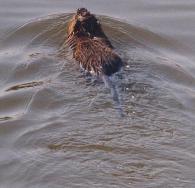 Nutria at the Hula wetlands |
While we're on the topic of cute small animals, I should introduce the nutria, a creature I first met while on vacation in the USA, in Maryland's Eastern Shore region, where it has become established. In addition to Israel's many and diverse native animals, various species have been introduced or found their way here.
As in many parts of the world the Latin American nutria has made itself at home in Israel's reservoirs, fish ponds and other water sources. It was brought here originally in the early 1950s for its fur, but some individuals escaped and today there is a well established Israeli nutria population.They are especially easy to spot in the Hula Valley nature reserves in northern Israel. Look out for them swimming in the lakes and drainage channels or nibbling waterside vegetation.
Israeli Wildlife |
Biblical Animals |
Hai Bar Conservation Programme
Israeli Mammals |
Small Israeli Mammals |
Israeli Reptiles |
Israeli Birds |
Israeli wildlife links
Copyright 2005 by Leiah Elbaum. Text and photographs on this page are by Leiah Elbaum. Last updated 5 May 2005.